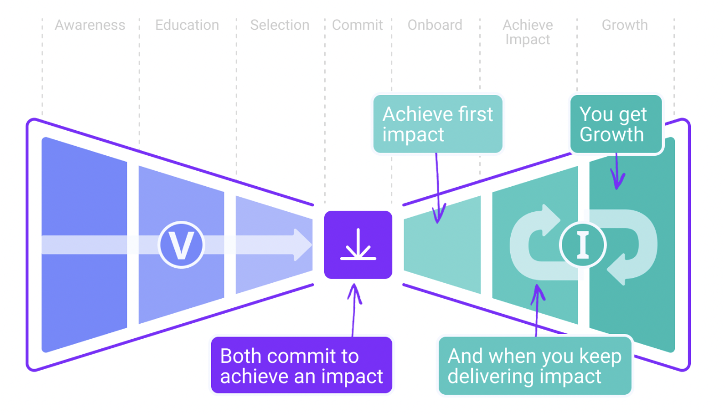 Blood, sweat, tears and a whole lot of financial investment is needed to win new logos in SaaS sales. While the cost of customer acquisition varies widely by industry, Gartner cites that “the median customer acquisition cost (CAC) among technology companies with less than $250 million in annual revenue is $27,000.” Top that with the fact that acquiring new customers has risen more than 50% in the last five years alone. While you need new customers to grow your company, acquisition is a pricey proposition and there is so much more to it.
Blood, sweat, tears and a whole lot of financial investment is needed to win new logos in SaaS sales. While the cost of customer acquisition varies widely by industry, Gartner cites that “the median customer acquisition cost (CAC) among technology companies with less than $250 million in annual revenue is $27,000.” Top that with the fact that acquiring new customers has risen more than 50% in the last five years alone. While you need new customers to grow your company, acquisition is a pricey proposition and there is so much more to it.
Growth is not solely about acquiring new customers — it’s also about expanding relationships and keeping your customers happy for the long haul. A net revenue retention (NRR) strategy can help you do all this while scaling revenue and accelerating growth beyond what new customer acquisitions can do for you.
What Is Net Revenue Retention?
NRR is a way to view customer growth through expansion and retention. Suppose you started the year with 10 new customers each paying you $1,000, summing up to $10,000 on Jan. 1. By the end of the year, you would assess the value of those same 10 customers. If three customers, amounting to $3,000 in revenue, churned, your gross revenue retention (GRR) would be 70%. However, if the remaining seven customers expanded their contracts by an additional $13,000, your portfolio would amount to $20,000, resulting in a 200% NRR.
Why NRR Matters For Marketers
Marketing to existing customers is closely connected to NRR, as a high NRR indicates that marketing efforts are successfully retaining and expanding revenue from the existing customer base. Effective marketing strategies promote upsell and cross-sell opportunities for the existing customer base. Moreover, marketing to existing customers fosters loyalty and advocacy, encouraging customers to stay with the brand and refer it to others.
The Bowtie Model: A Holistic GTM Approach
NRR has not typically been fully leveraged as a pillar of growth because a typical go-to-market (GTM) funnel is optimized toward new, local customer acquisition. If this is your model, you may be asking questions such as:
● How many leads are we getting?
● What is our conversion rate?
● How many new customers are we signing?
But what if you shifted your model framework to a process what Winning by Design Research & Development describes as a bowtie? The left side is the customer acquisition side, and then the right side is the customer lifecycle side.

A bowtie model illustration, created by Influ2.
The Power Of The Bowtie Model
The Bowtie Model helps visualize the best ways to reach your targets. You don’t need to just scale one piece of the bowtie to grow your revenue, and if you execute better in every piece of the bowtie puzzle, you can grow quite a bit faster without herculean feats of valor on the customer acquisition side.
The Bowtie Model offers marketers a big-picture view of the customer before and after the initial sale. Building a deep understanding of B2B decision-makers empowers marketing teams to efficiently engage with customers, improve the overall customer experience and build trust in the brand. It also encourages marketers to deeply understand customers throughout the business relationship, enabling them to create more informed and compelling campaigns.
5 Steps To Improve Your NRR
1. Shift your revenue paradigm from customer acquisition alone to LTV of a customer.
Activate your marketing efforts across the entire bowtie rather than focusing primarily on new logos. Quantify the effect you will have at every stage of the “bowtie” from acquisition throughout the entire lifecycle of a customer and look for ways to accelerate your impact.
2. Make revenue processes that you can replicate with an eye toward growing the long-term value of your customers
Remember, often companies rely on increases to boost revenue, but sometimes that can be detrimental. It’s possible to oversell customers with a higher ASP when, if you sold them at a lower amount, you might actually get a longer lifetime value out of them because they’ll be successful with the smaller amount. And then they’ll expand. And they’ll grow. And you’ll retain them.
3. Optimize revenue at each phase of the customer journey through great experiences that deliver impact
Create great experiences at each stage and touchpoint of the relationship rather than leaving off at solely optimizing everything around new local acquisition.
4. Align the goals, incentives and KPIs across the commercial team
If account executives get compensated solely on the initial deal size for a new logo, they’re going to try to extract every dollar possible on that initial deal versus what’s good for LTV of the customer. So, it’s critical for everyone on the commercial team to align with the appropriate incentives that match the goals.
5. Organize your teams for growth
Having a Chief Revenue Officer (CRO) with full-funnel revenue oversight is ideal to champion the effort. If there’s no CRO and there are multiple chiefs from various organizations, the CEO can create alignment between the groups, having the same definition of what it means to win and corresponding ways to measure success.
While customer acquisition costs might not decrease soon, marketers can still make a significant impact on revenue by supporting an NRR strategy. By nurturing and expanding existing customer relationships, focusing on their lifetime value, and aligning the entire team’s efforts, marketers can play a crucial role in driving sustained growth and success for their SaaS companies.
Joe McNeill is the CRO of Influ2, a person-based advertising company.







